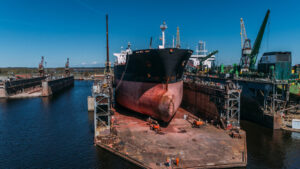A dock is a structure that allows boats to be docked or moored. Like other structures, docks need to be repaired regularly to prevent structural damage and maintain safety.

During routine inspections, owners should check for issues like foundation cracks or frame damage. Repairing these problems quickly can save money and time. Contact Lake Norman Dock Builder for professional help.
Wood rot is one of the most common problems that docks face. This is a fungal disease that eats away at the wood, and it can be difficult to spot in its early stages. It is also hard to repair and may require replacement of parts of your dock. If a large area of your dock has rot, you should call in a professional to assess the damage and determine the best course of action for repair or replacement.
While it is impossible to prevent wood rot completely, you can take steps to slow down the process. You can do this by regularly cleaning your wooden dock with an environmentally friendly cleaner, and resealing any boards that have an open end. This will help to keep moisture from penetrating the wood and making it a breeding ground for wet rot fungus.
It is also a good idea to keep a wood filler on hand in case you need to patch up any damaged areas of your dock. These products, which look like cookie dough, are easy to pack into the holes left by rot and will bond tightly. You can find these products online or at any home improvement store. Once the rot is removed and the filler has set, you can sand the surface and paint or stain it to match the rest of your dock.
Another way to slow down the process is by replacing any rotting pieces of your dock immediately. This will avoid the rot from spreading and make the rest of your dock look better.
You should also regularly inspect your dock for cracking or sagging. These signs of deterioration are an indicator that the foundation of your dock is starting to fail, and it will need to be replaced as soon as possible. This could mean piering or polyjacking, both of which should be done by a qualified professional to ensure your dock is safe for boats and people to use for years to come.
Lastly, if you notice any rust on metal components of your dock, this is an indication that they are starting to corrode and need to be replaced. This can be an expensive project, but it is vital to keeping your dock safe for boats and people to use for years.
Cracks and Warps
Whether they’re made of wood, concrete or metal, docks are susceptible to damage caused by waves, currents, wind and other environmental conditions. This can cause cracks, warps and other deterioration that may lead to the need for repairs or even replacement of the entire dock. Oftentimes, these types of issues can be repaired by professionals, but in other cases, it’s simply a matter of replacing the dock entirely to prevent further damage and ensure safety for anyone who uses it.
Regardless of the material used, all docks must be regularly inspected for damage and to determine if it’s time for a repair or replacement. Cracks in the foundation of a dock or on the surface should be addressed immediately as they pose a serious safety hazard. Generally, the foundation of a dock can be repaired fairly easily by adding a new layer of concrete over the existing one to stabilize it. This can be done without disrupting any of the existing structure, which makes it a relatively inexpensive and quick solution to a major problem.
For docks that have wood components, the most common issue is wood rot caused by a fungus that can spread rapidly. In some cases, rotting wood can be repaired by replacing individual boards with new treated wood that has gone through a preservation process. It’s also a good idea to stain any replaced board to match the color of the existing ones on the dock to help conceal the repair work.
Warps and bends in the supports of a dock are caused by constant pressure from waves and currents that can be exacerbated by people running boats into the structure or hitting them while docking. Depending on the severity and where these problems are located, it may be possible to repair or replace individual sections of the dock, but in some cases, the whole structure needs to be replaced.
For metal docks, rust is another common problem that can quickly deteriorate the integrity of the structure. In some cases, rust can be repaired by repainting the affected areas with a high-quality marine paint. However, if rust is spreading to multiple parts of the dock or the foundation, it’s likely time for a replacement.
Rust
Docks are exposed to water, sun, rain and wind on a constant basis. Over time, these elements can cause wear and tear that requires repair. A well-established maintenance plan will keep your loading dock equipment functioning properly and reduce downtime and operational costs.
Dock maintenance includes regular inspections for rot, cracks and rust. Inspecting the structure at the beginning and end of each season is a great way to spot problems early on and address them quickly. A thorough inspection can also detect issues that may be brewing but haven’t yet become noticeable.
Rust is a common issue for docks, especially those that are located in salt water environments. Even galvanized metals can corrode and eventually need to be replaced. If rust is found on major components or a significant amount of the structure, it’s usually best to replace the dock completely to prevent safety risks.
Another sign that a dock is in need of repair is if it begins to sag. A sagging dock can create dangerous conditions for boaters and needs to be repaired as soon as possible to avoid serious structural damage. A sagging dock can also indicate that the foundation of the structure is deteriorating and will need to be replaced.
Wood rot is another common issue for docks and can be particularly harmful to boats. If the rotting is limited to non-load-bearing areas, it’s typically a simple fix that can be done by replacing the affected boards with treated lumber. It’s also a good idea to treat all piers and supports with a waterproof seal to help protect them from the elements and fungal decay.
Other common dock repair issues include a damaged foundation or extensive hurricane damage. A deteriorated foundation can cause the entire structure to collapse, which is a major safety risk for anyone who uses it. A qualified professional can assess the foundation and determine the most effective solution for repairing it, which might include piering or polyjacking. These repairs can be quite costly, but they are necessary to keep the dock safe for boaters and swimmers.
Pile Wrap
Pile wrap protects dock pilings from marine borers, which eat away at the wood and can cause structural problems for the entire dock. Our heavy-duty piling wrap is made of durable materials and affixes to the sides of a pile, shielding it from marine borers. It’s also easy to add to existing docks and can help extend the life of a pile.
The problem is exacerbated by the constant movement of water and the tide, which causes stress on a piling that’s being constantly exposed to the elements. This stress can make it a lot easier for the borers to find a hole in the piling and start eating away at it, which weakens it and makes it more susceptible to other damage.
This is why it’s so important to protect your pilings with either a piling cap or a piling wrap. Piling caps seal the tops of a pile and can be constructed of a variety of materials, including metals like copper, or plastics such as vinyl. While they’re labor-intensive to install, these caps can last for decades and help reduce the need for future repairs.
While the industry standard for new marine piles is to affix a thin black plastic wrap to them, this isn’t a great solution. Because the wrap is nailed to the pile, it’s vulnerable at points where marine growth builds up or as the nails start to rust and the wrap rips over time.
A better solution is to use a system like SnapJacket, which involves “snapping” plastic wraps around a pile and then sealing them with concrete. This is much more effective at protecting a pile from borers and can fortify decayed or eroded wood, too.
This type of repair can save you the cost and hassle of replacing your dock’s pilings in the future, and it’s also a much more environmentally friendly solution than digging out old pilings for replacement. To learn more about how our piling wraps can protect your dock and extend its life-time, contact us today. We’ll gladly answer any questions you have.
